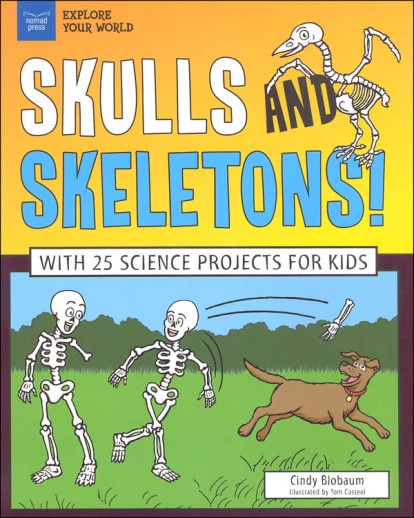We use cookies to make your experience better. To comply with the new e-Privacy directive, we need to ask for your consent to set the cookies. Learn more.
Explore Your World: Skulls and Skeletons! With 25 Science Projects for Kids
Rarely seen (and that’s a good thing!), but necessary for survival, our skeleton shapes and supports the body. Understanding the skeletal system is a terrific, practical way to apply science. Offering 25 STEM and critical thinking activities, this book teaches foundational information in a way kids can understand, with hands-on projects guiding students into inquiry-based learning. Activities include dissolving calcium from bones, measuring brain volume, designing a skull model and more. Requires easy-to-find items for activities. Children will also learn what they can do to stay bone healthy! ~Deanne
What would happen if you had no bones? You might fall over flat on the floor!
Bones are those hard parts of our bodies that make up our skeletons and skulls, and we need them in lots of different ways. In Skulls and Skeletons! With 25 Science Projects for Kids, readers learn about the bones in their bodies and why we can't live without them. And bones aren't just good for humansmany animals can't live without them! But do all animals have bones? No, they don't! And why do fish look so much different from birds, even though both have bones? Organisms use their bodies in different ways to successfully live in different habitats. For example, a bird's light bones are great for flying, but would not support them deep in the ocean.
Explore Skulls and Skeletons encourages readers to learn as they compare and contrast their own bones with those of other vertebrates. They make working models, measure bone lengths and brain capacity, learn how to identify skulls and bones by shape, structure, and functions, and much more! Bones provide the framework that allow our muscles and organs to do their jobs. They also protect important body parts, provide a place for muscles to attach, and even make our blood. By exploring the skeletons that make up our bodies, kids gain foundational knowledge about how bodies work and what people can do to stay healthy.
Explore Skulls and Skeletons includes hands-on STEM activities and critical thinking exercises related to anatomy and biology. Fun facts, links to online primary sources and other supplemental material, and essential questions encourage readers to take a deep dive inside their own bodies!
Try these hands-on anatomy projects!
- Measure brain volume with sand or rice
- Compare finger adaptations
- Design a skull model
This series explores STEM concepts and applied sciences. Each book includes 25 projects, averaging a few each chapter. Projects can vary from the simple (like making ocean salt water or forming an arch with your body) to more complicated STEAM projects (wind force; building design; or learning binary code). Adult supervision recommended for these kid-friendly projects. Call-Out sections include explanatory text, vocabulary with definitions, "Did you Know?" sections (with cool "factoids"), Investigate questions, project directions—and even "dad jokes." Throughout each book, periodic QR codes help readers explore additional concepts on external websites. You'll be able to choose from a few activities or match an activity to your child's appropriate grade—or have your budding scientist engage in them all! Includes a theme-focused timeline, essential questions, metric conversions, glossary, resources, and index. See each product description for specific content. Printed in the U.S. Size is 8"x 10". 90 pgs, pb. ~ Ruth
| Product Format: | Paperback |
|---|---|
| Brand: | Nomad Press |
| Grades: | 2-5 |
| ISBN: | 9781619308091 |
| Length in Inches: | 10 |
| Width in Inches: | 8 |
| Height in Inches: | 0.25 |
| Weight in Pounds: | 0.55 |

